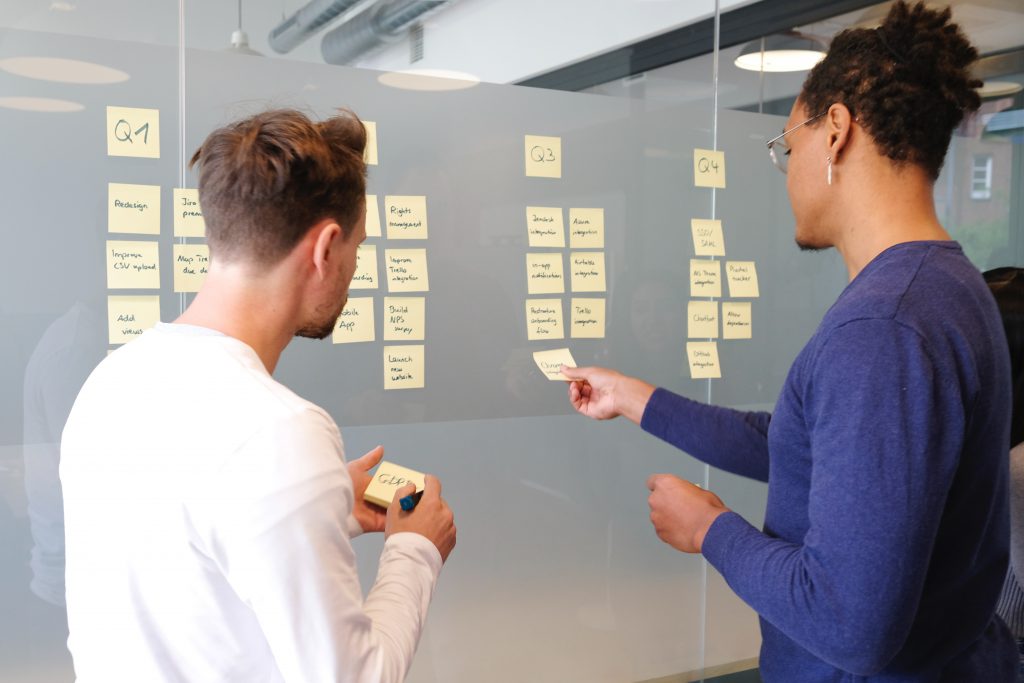The SaaS industry is a highly competitive and fast-changing market. The latest data suggests that approximately 30,000 SaaS companies currently exist worldwide. With over 90% of SaaS startups failing and 60% never making a profit!
Evolving technologies, customer needs, market trends, and competitor actions can ultimately make or break your product’s success. So how do you keep up with this dynamic environment to ensure you deliver a SaaS product that meets your vision, business goals, and customer expectations?
You need an agile SaaS roadmap that is informed by accurate and up-to-date competitive intelligence to help guide you through the ever-changing market conditions.
Competitive intelligence not only helps you understand your competitors’ strengths and weaknesses — it also helps you identify gaps, trends, and best practices that you can leverage for your own product development and growth.
In this article, we’ll show you how to create an effective SaaS roadmap that is driven by competitive intelligence.
We’ll cover the key components of a SaaS roadmap, the benefits of using competitive intelligence, and the necessary steps for building a SaaS roadmap that will successfully guide you towards achieving your product goals.

What’s A SaaS Roadmap?
A SaaS roadmap is a vital tool that helps you visualise key milestones and objectives for your SaaS product — such as launching new features, expanding into new markets, or increasing customer satisfaction.
It provides both a high-level overview and an in-depth perspective for the various stages of your SaaS product development lifecycle.
The main role of your SaaS roadmap is to create an actionable plan that strategically guides your product development over time. Allowing for customer-centric planning, efficient resource allocation, and data-driven decision making.
A SaaS roadmap is not a static or rigid document that you create once and never change. It requires constant monitoring, evaluation, and adjustment in order to keep up with market conditions, competitors and customer expectations.
An Effective SaaS Roadmap: The 7 Key Components
A SaaS roadmap is not a generic template that can be universally applied to any product. It needs to be an accurate reflection of your product’s specific vision, goals, and the current competitive landscape.
While each roadmap is distinct to reflect the individuality of the SaaS solution it represents, an effective SaaS roadmap should always include the following key components:
1) Objectives
Objectives are the high-level goals that your SaaS product aims to achieve. They ultimately provide direction and purpose for your feature development and product launch activities.
Clear objectives ensure that every feature you develop and every decision you make contributes to your overall success. Examples of objectives to include in your SaaS roadmap:
- Increase user engagement
- Expand market reach
- Improve product performance
- Achieve revenue targets
2) Features
Features are the specific functionalities of your SaaS product that provide value to your customers. They are the tangible aspects of your product that customers interact with. A well-planned feature set can differentiate your product from competitors and ensure a positive customer experience.
Examples of features to include in your SaaS roadmap:
- New capabilities
- Integrations
- Current feature enhancements
- Bug fixes
- Security improvements
3) Timelines
Timelines provide a schedule for when each feature or objective will be completed. They help manage expectations among stakeholders and keep your product development process on track.
Timelines also allow for better resource allocation, ensuring that tasks are completed efficiently and effectively. Examples of timelines to include in your SaaS roadmap:
- Yearly timelines
- Quarterly timelines
- Monthly timelines
- Weekly timelines
- Sprints
4) Market insights
Market insights include information about your target customers, competitors, and industry trends. These insights inform your product strategy, helping you make decisions that align with market demands and opportunities.
Understanding the market is crucial for developing a SaaS product that meets your customers’ needs and stands out amongst competitors. Examples of market insights to include in your SaaS roadmap:
- Market trends
- Market segmentation
- Customer feedback
- Competitive intelligence
- Competitor analysis
- Industry reports
5) Metrics
Metrics are the quantitative indicators that measure the progress and performance of your product. They help you track and evaluate how well your product is achieving its objectives and delivering value to your customers.
Metrics also provide crucial feedback for improving your product and validating your assumptions. Examples of metrics to include in your SaaS roadmap:
- Customer acquisition cost (CAC)
- Customer lifetime value (CLV)
- Churn rate
- Net promoter score (NPS)
- Monthly recurring revenue (MRR)
6) Risks
Risks are the potential challenges or uncertainties that could affect your product development and overall success. They include both internal and external factors that could severely impact your product quality, delivery, or customer satisfaction.
Identifying and managing risks will help you mitigate or avoid negative outcomes to ensure your product consistently meets its primary objectives. Examples of risks to include in your SaaS roadmap:
- Technical debt
- Security breaches
- Regulatory changes
- Competitor innovation
- Product obsolescence
7) Dependencies
Dependencies are the relationships or interconnections between different elements of your product or organisation. They include both internal dependencies, such as the tasks or resources required for completing a feature; and external dependencies, such as the third-party services or platforms that your product relies on.
Understanding and managing dependencies will help you coordinate and prioritize your product development efforts to avoid any delays or conflicts. Examples of dependencies to include in your SaaS roadmap:
- APIs
- Libraries
- Frameworks
- Integrations
- External software

Integrating Competitive Intelligence Into SaaS Roadmaps
You need to constantly be aware of what your competitors are doing, what customers are saying about them, and how the market is responding. This is where competitive intelligence comes into play.
Competitive intelligence provides you with invaluable insights into the market and allows you to make informed decisions about your product strategies, feature prioritisation, and market opportunities.
For instance, if a competitor launches a new feature that’s well-received by customers, you might consider adding a similar feature to your product. Conversely, if a competitor’s feature is met with negative feedback, you can learn from their experience and avoid making the same mistake.
And if there’s a gap in the market that your competitors are simply not addressing, that’s a great opportunity for you to capitalise on. Integrating competitive intelligence into your SaaS roadmap is not just beneficial — it’s essential.
It allows you to stay agile, ensuring your product evolves with the market and consistently meets the specific needs of your ideal customers.
5 Steps For Integrating Competitive Intelligence Into A SaaS Roadmap
Below is a step-by-step guide that details how you can integrate a competitive intelligence your SaaS roadmap:
1) Identify Competitors
Start by identifying who your competitors are. Analyse direct competitors who provide a similar product to the same audience. Also, take into account indirect competitors who either offer a different product to the same audience, or a similar product to a different audience.
2) Gather information
Use various sources to gather information about your competitors. This can be achieved by analysing their websites, customer reviews, social media activity, industry reports, etc. Utilise competitive intelligence tools to efficiently gather reliable and up-to-date information.
3) Analyse the information
Once you’ve gathered the information, analyse it thoroughly to gain insights. Look for indicators such as patterns, trends, strengths, and weaknesses. Pay close attention to certain factors like product features, customer satisfaction, and pricing strategies.
4) Incorporate insights into Your roadmap
Leverage the insights you’ve acquired to inform and shape your SaaS roadmap. These important insights can influence what features you decide to build, how you prioritise them, and how you position your product in the market.
5) Monitor continuously
The market and your competitors will continue to evolve, so it’s important to continuously monitor them and update your roadmap accordingly. Remember, the goal of integrating competitive intelligence into your SaaS roadmap is not to copy your competitors.
It is to help you make informed decisions that align with current market trends, customer needs, and your own product goals.
How To Create Your Own Product Roadmap
Creating a SaaS roadmap is a calculated process that requires careful planning and cross-functional collaboration. It needs to function as a tactical guide for your entire organisation, aligning everyone towards achieving common goals.
Below is a step-by-step guide to help you create an effective SaaS roadmap for your product:
Step 1: Define your primary objectives
What are the long-term goals and objectives for your SaaS product?
Define a clear and compelling vision that details the main objectives that you want to achieve. Your primary objectives essentially guide your roadmap, as it defines the overall direction and purpose of your product development.
Step 2: Understand your customers
Who are you building your product for?
You need to have a deep understanding of your target customers’ needs, pain points, and expectations — such as the problems they are facing, what solutions they are looking for, and what outcomes they want to achieve.
Use various methods to gather customer feedback, such as surveys, interviews, user testing, and reviews.
You can also utilise other research techniques, such as creating personas, user journeys, or empathy maps to further understand exactly who your customers are.
Step 3: Conduct competitive analysis
What are the strengths and weaknesses of your competitors?
You need to know what features they offer, how they market their products, how they interact with their customers, and how they perform in the market.
Leverage reliable and accurate competitive intelligence tools to monitor their activities to ensure the insights you gather are dependable. Identify gaps in the market that your product can effectively fill or capitalise on.
Step 4: Prioritise features
What specific features will make your product stand out and meet the needs of your customers?
Prioritise these features based on customer demand, business value, and development effort. Use prioritisation frameworks like RICE (Reach, Impact, Confidence, Effort), MoSCoW (Must have, Should have, Could have, Won’t have), Opportunity Scoring, and Cost of Delay to effectively rank and select high-priority features for your SaaS development lifecycle.
Step 5: Collaborate with cross-functional teams
How can you leverage the expertise of different teams within your organisation?
It’s essential to collaborate with the other teams within your organisation during the roadmap planning process — such as sales, marketing, customer support, and engineering.
By collaborating with cross-functional teams, you can leverage their diverse perspectives and expertise to create a more effective roadmap and ultimately a better product.

Benefits Of A Competitive SaaS Roadmap
A SaaS roadmap informed by competitive intelligence offers numerous benefits and advantages. It serves as an actionable blueprint that helps guide effective product development, market positioning, and sustainable growth.
A) Effective product development
Understanding what competitors are doing in the market allows you to successfully identify gaps and opportunities for your own product development. A competitive roadmap allows you to prioritise key features or improvements that will provide the most value to your customers.
B) Enhanced market positioning
Staying well-informed about the competitive landscape allows you to make strategic decisions that help your product stand out from the crowd. A competitive roadmap will enable you to enhance your market positioning through the development of superior features and functions.
C) Sustainable growth
Continuously monitoring competitors and adapting your product development strategy allows you to stay ahead of market trends, seize new opportunities, and avoid potential threats.
This proactive approach can lead to increased customer satisfaction, improved retention rates, and sustainable growth for your product.
Concluding Thoughts
The dynamic nature of the SaaS industry demands an approach that is both adaptive and well-informed. Competitive intelligence is not just a valuable tool to help you achieve your product goals; it is the bedrock which effective SaaS roadmaps are built upon.
As we’ve explored in this article, an effective SaaS roadmap should encompass key components like objectives, features, timelines, market insights, metrics, risks, and dependencies.
However, the secret ingredient that transforms a regular SaaS roadmap into an effective one is competitive intelligence. Competitive intelligence empowers you to navigate the fast-changing SaaS world with precision and foresight.
It’s the compass that guides your product development, the beacon that enhances your market positioning, and the engine for achieving sustainable growth.
By identifying your competitors, gathering valuable insights, analysing the information, and incorporating these insights into your SaaS roadmap — you gain a competitive edge that ensures your product evolves in harmony with the market and your customers’ specific needs.

